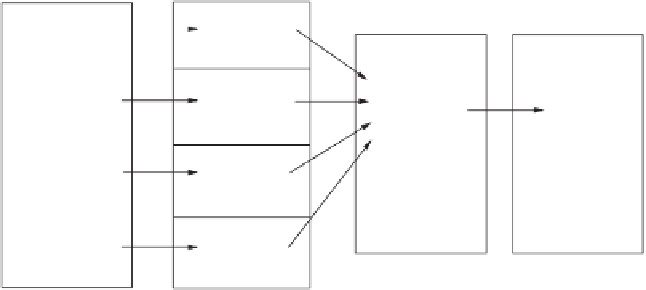Information Technology Reference
In-Depth Information
Depending on the size and complexity of the application being developed, there
may be multiple smaller staging environments for major subcomponents of the ap-
plication. For example, an enterprise-wide application may have separate staging
environments for the accounting subcomponent, the marketing subcomponent, the
manufacturing component, and the warehousing component. All of these subcom-
ponent staging environments represent excellent testing environments prior to the
complete enterprise-wide application availability for testing. Figure 10.2 shows what
a complex computing environment strategy like this might look like.
Development
environment
Staging (t est)
environments
Final staging
(t est)
environment
Production
environment
Accounting
subsystem
Accounting
Untested and corrected
Enterprise-
wide
application
Enterprise-
wide
application
Marketing
subsystem
Marketing
Untested and corrected
Manufacturing
subsystem
Manufacturing
Untested and corrected
Untested and
corrected
Te ste d
software
only
Warehousing
subsystem
Warehousing
Untested and corrected
Figure 10.2
Complex computing environment strategy
It is important for the test team to control the test environment from a test sched-
ule perspective and from a data reload and rerun perspective. Control of the testing
environment needs to encompass the additional dimension of controlled staging or
“builds.” A “build” is the collection of specifi c versions of application components
for executing specifi c test cases. When software is ready to be tested, that software
must be moved somehow from the development environment to the testing environ-
ment. Staging of software from development to test is typically accomplished either
by manual procedures or by automated staging tools.
The lifetime of a test environment is determined by several factors. If the soft-
ware being developed is expected to have multiple versions over a number of months
or years, then it makes good sense to establish and maintain a reusable test environ-
ment for the duration of the software development schedule. The economy of scale
is derived from the increasing number of subsequent versions tested in the same test
environment because the cost of personnel to set up and tear down a testing environ-
ment will exceed the cost of the test hardware over time.
When it is clear that the testing environment is needed for just a small number
of versions to be tested or the time in between version tests is months or years, then
a short-term testing environment might make more economic sense. The largest cost
of setting up a short-term testing environment is usually the hardware cost. It is very
diffi cult to justify the outright purchase of hardware for one or two tests. Often, it

Search WWH ::

Custom Search